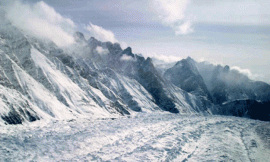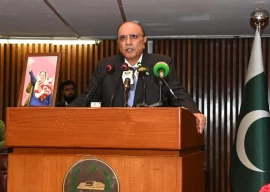
PESHAWAR: The ruins of Takht Bhai, ‘spring upon a rocky ridge’, do not fail to fascinate anyone who visits. Apart from the rich culture and heritage that is preserved at the site, the threads of myths woven around the Buddhist monastery, offer multiple narratives and accounts of the history of the place.
Situated on the Mardan-Swat Road, around 13 kilometres north of Peshawar, the Takht Bhai ruins date back to the 2nd century BC. It was excavated in 1836 and was declared a world heritage site by Unesco in 1980.

Sifting through accounts
Every local narrates his or her version of the historical facts about Takht Bhai.
“The ruins had underground waterways which were constructed to provide water from springs to the people living on the hills,” a local told The Express Tribune.
“A king would sit on a massive throne in the middle of these ruins and bread and meals would be prepared for him at the base of the site,” another local said.
Encounters with more people only add to the rich tales the region has created about the site.

According to archaeologists, the ruins of Takht Bhai were first excavated in 1836. At least 270 sculptures—220 made of clay, stucco and terracotta—reflecting complex iconography have been discovered and displayed at Peshawar Museum. Archaeologists believe Takht Bhai was a major ancient Buddhist monastery complex.
“These monasteries date back to the reign of Parthian King Gondophares who took a keen interest in religion,” an official of the archaeology department told The Express Tribune.
The department officials explained that Takht Bhai was built 500 feet above the ground on the flank of mountain. It is one of the 60 monasteries that were constructed on connecting ridges in the area.

“Since the site served as a religious ground, pilgrims from China and the Subcontinent would visit the area until it was damaged by the Hans of Central Asia,” one of the officials said. He added since Takht Bhai was situated on the top of a mountain, it could not be destroyed.
From the top of the mountain, a panoramic view of plains extending from Malakand Pass to the Hindu Kush mountainous range, can be seen.
Need to curb vandalism
Muhammad Usman Mardanvi, an archaeologist from Mardan, told The Express Tribune the site needed to be preserved more.
“Originally, the monasteries were multi-storey structures with the conventional pattern of the main stupa surrounded by small heterogeneous ones,” he said, adding, stupas were embellished with narratives. “There were chapels, underground meditation centres and several water channels which reveal how systematic constructions of that era were,” he said.
The archaeologist also said Takht Bhai was made in a way that would prevent destruction from seismic activity. “However, today, visitors climb walls, scribble on them and have dismissed the fact that the site is in fact a building of historic importance.
“It is forbidden to even scratch the walls but people have scribbled on them,” Mardanvi lamented. He said there needs to be a strong check on visitors who were unaware of the significance of the ruins.
“People come to the site for picnics – they cook, litter and damage the area,” he said.

Gearing up
The Directorate of Archaeology and Museums has been making three-dimensional videos to protect the site for future generations and attract tourists from within and outside the country.
“The revenue generated from international tourists is thin despite the fact that law and order situation in the province has improved,” Mardanvi said.
He added Mardan was the ‘land of Gandhara’ and was the heart of the ancient civilisation. “Besides Takht Bhai, there are several important sites in the area, including, Sehri Bahlol, Shahbaz Garhi, Jamal Garhi, Sawal Dher, Chanakai Dheri and Aziz Dheri.” He said Mardan should follow the example of Malakand Division and lift travel restrictions so that tourists could experience the diverse culture and history of the areas.
Published in The Express Tribune, August 26th, 2016.

















































COMMENTS
Comments are moderated and generally will be posted if they are on-topic and not abusive.
For more information, please see our Comments FAQ